- Submissions

Full Text
Novel Approaches in Cancer Study
Age to Begin Cigarettes Smoking and Factors Associated with it Among Youths (Age 15- 24 Years) in Hawassa, Ethiopia
Kaleab Tesfaye Tegegne*
Department of Public Health, Hawassa College of Health Science, Ethiopia
*Corresponding author:Kaleab Tesfaye Tegegne, Department of Public Health, Hawassa College of Health Science, Ethiopia
Submission: August 5, 2022 Published: August 23, 2022

ISSN:2637-773XVolume7 Issue3
Abstract
Background:Inhaling the fumes and hydrocarbon vapors produced by slowly burning tobacco in cigarettes is referred to as cigarette smoking. As a result, the study’s goal was to find out when young people in Hawassa, Ethiopia, started smoking and what reasons influenced them to do so.
Methods: From April 1 to April 30/2022, a community-based cross-sectional study was conducted in Hawassa, Ethiopia. Kaplan-Meier (KM) analyses were used to assess the likelihood of cigarette smoking at a particular age. With the outcome variable of having ever smoked a cigarette before and the follow-up period of age, the Cox proportional hazards model was used. In addition, logistic regression was used to assess potential cigarette smoking predictors.
Result: Age (AOR, 95%CI 1.56 (1.03, 2.38), believing that smoke from other people does not affect me (AOR, 95%CI, 0.03 (0.001, 0.85), and living with people who smoke (AOR, 95%CI, 0.02 (0.002, 0.242), are all characteristics linked to cigarette smoking, according to multivariate analysis. Cox proportional hazards model for youth who had ever smoked cigarettes using age as a follow-up period showed the youth who drink alcohol is more likely to have a shorter time to begin smoking than those who did not ever drink alcohol (AHR) (95%CI)) =6.22 (1.60, 24.21)
Conclusion: Cigarette smoking is found to be substantially associated with factors such as age, believing smoke from other people does not damage me and living with individuals who smoke.
Knowledge of the health implications of cigarette smoking did not prevent smoking, and we propose that more research be done on the relationship between knowledge of the health impacts of smoking and smoking behavior. More research is needed to determine the impact of living with smokers on one’s smoking status.
Keywords: Youth; Cigarettes smoking; Ethiopia
Introduction
Inhaling the fumes and hydrocarbon vapors produced by slowly burning tobacco in cigarettes is referred to as cigarette smoking [1]. From childhood through maturity, adolescence is a complicated developing stage that includes natural and physical growth as well as social interactions that can have both short-and long-term implications [2]. Smoking is one of the most serious public health issues in the world, as well as one of the most preventable causes of death [3]. Tobacco kills around 6 million people each year and costs the global economy more than half a trillion dollars. Although tobacco smoking remains the greatest cause of preventable death worldwide, there are proven, cost-effective ways to tackle this terrible scourge [4]. The annual death toll might soar to more than eight million by 2030 unless urgent action is taken [4]. According to the Ethiopian Demographic and Health Survey (EDHS) 2005 report, 9% of Ethiopian men aged 15 to 49 consume cigarettes [5]. Smoking among youth is linked to exposure to smokers (friends, parents, instructors), tobacco availability, low socioeconomic position, poor academic achievement, low self-esteem, a lack of perceived risk of usage, and a lack of skills to resist tobacco-related pressures [6-8]. Getting into physical fights, drinking alcohol, smoking marijuana, and having sexual relations are also linked to cigarette smoking [9]. Identifying the causes of cigarette smoking prevalence provides better evidence for policymakers, program planners, and youth and sport administrators to develop effective interventions among youth to reduce smoking prevalence. Furthermore, the data may be used as a guide for researchers who want to undertake more research on cigarette smoking among teenagers. As a result, the study’s goal was to find out when young people in Hawassa, Ethiopia, started smoking and what reasons influenced them to do so.
Methodss
The study’s design, setting, and timeframe
From April 1 to April 30/2022, a community-based crosssectional study was conducted in Hawassa, Ethiopia.
Participants in the research
All young people aged 15 to 24 who use social media (Facebook and Telegram) and live in Hawassa were included in the study’s source population. and All youths aged 15 to 24 who accessed the internet during the study period were deemed study populations.
Sampling technique and sample size
The sample size was calculated using the single proportion formula and the 11 percent p-value from a previous study conducted in Hawassa [10]. The single proportion formula was utilized in the cross-sectional study design (n = required sample size n=Z(/2)2pq/d2).
To determine the ultimate sample size, P=0.11, q(1-p) =0.89, 95% CI and 5% margin of error was used.
n=required sample size n=Z (α/2)2 pp./d2, p=0.11
= (1.96) (1.96) (0.11) (0.89)/ (0.05) (0.05) =150
N = non-response rate 10% =15, the total sample size was, 150+15=165
The sampling technique was consecutive sampling.
Data collection procedures and instruments
Two master’s degree public health and health informatics specialists used an online self-administered questionnaire to collect data. After generating the online data forms of the questionnaire, we sent telegram and Facebook inbox messages to each responder, and they returned to us as a reply after filling out the questionnaire. Questions from the Global Youth Tobacco Survey (GYTS) were adjusted to Ethiopian settings to investigate smoking tendencies. GYTS is made up of two parts: a core and an add-on. Optional questions were used in Ethiopia to address specific difficulties, while the core component was used in all countries participating in the Global Youth Tobacco Survey, which includes an international analysis of results. The instrument was adapted for the Ethiopian environment during pre-testing, and the questionnaire’s reliability was assessed using Cronbach’s alpha (On the Cronbach’s scale, Alpha = 0.74). The questionnaire included questions about sociodemographic, economic, and behavioral aspects, as well as smoking behaviors.
Data quality control
To guarantee consistency, the English version of the questionnaire was first translated into Amharic, the official language of the study area, and then back into English. The data collectors used the Amharic version of the questionnaire for data gathering. One week before the actual data collecting began, the investigator administered a pretest with 21 respondents. The data collectors and supervisors were trained for four days on the study’s aims by the researchers. Before entering the data, the supervisors checked all the data collectors for completeness of the questionnaire on an online survey site and removed any that were not.
Statistical analysis
The data was cleaned, coded, and entered EPI INFO version 3.3 for Windows, after which it was analyzed with SPSS 23.0 for Windows. For both descriptive and analytical aims, statistical techniques were applied.
The T-test was used on two distinct samples to examine if there was a significant difference in smoking status between males and females. Kaplan-Meier (KM) analyses were used to assess the likelihood of cigarette smoking at a particular age. With the outcome variable of having ever smoked a cigarette before and the follow-up period of age, the Cox proportional hazards model was used. In addition, logistic regression was used to assess potential cigarette smoking predictors. In the Hosmer-Lemeshow goodness of fit test, the model fits with p values of 0.997. The Nagelkerke R Square demonstrates that this logistic model accounts for 60.9 percent of the variation in the outcome variable (kids who have ever smoked). The logistic model’s overall accuracy in predicting youth who have ever smoked (with a projected chance of 0.5 or greater) is 93 percent.
Ethical consideration
The ethical review board at Hawassa College of Health Science followed all protocols including the Helsinki Declaration throughout data collection. The ethical review board of Hawassa College of Health Science gave its approval to the project. The data collector informed the respondents that participated in the study was fully voluntary and that there would be no negative consequences if they declined. The data collector was requested online before the data was collected, and each participant gave their informed consent.
Result
Questionnaires were distributed to the 165 youth at Hawassa, and all the forms were returned, resulting in a 100% response rate. The average age of the youth was 18, with 116 (70.3%) of them being male. In terms of social status, 160 (97%) were unmarried and 96 (58.2%) were Orthodox Christians. Parents were the source of income for 118 (71.5%) of the youth. Twenty-one (12.7%) of the youths had ever chewed Khat, and 37 (22.4%) had ever consumed alcohol. Twenty-one (12.7 percent) of youths have ever smoked, whereas 144 (87.3 percent) have never smoked [11]. (6.7 percent) of all youth who had ever smoked were between the ages of 15 and 19, while 10 (6.1 percent) were between the ages of 20 and 24 (Table 1). Factors that influence whether you smoke cigarettes. Age, having a friend who smoked, chewed khat, alcohol ever uses, grade, living with people who smoke, believing smoke from other people does not damage me and having a history of illegal drug use were all characteristics linked to cigarette smoking, according to bivariate analysis. Age, believing that smoke from other people does not affect me, and living with people who smoke are all characteristics linked to cigarette smoking, according to multivariate analysis (Table 2). Odds of cigarette smoking increase by 56.8% for a one-year increase in age (AOR, 95%CI, 1.56 (1.03, 2.38), p-value=0.036. The odds of cigarette smoking decrease by 98% among youth living with people who smoke compared to those who do not live with people who smoke (AOR, 95% CI, 0.02 (0.002, 0.24), p-Value= 0.002). Youth who had to think smoking from other people did not harm me had a 96.6% decrease in the odds of using cigarettes compared to youth who think smoking from other people harms me (AOR,95% CI, 0.03 (0.001, 0.85), p-value=0.04). Cox proportional hazards model for youth who had ever smoked cigarettes using age as a follow-up period showed the youth who drink alcohol is more likely to have a shorter time to begin smoking than those who did not ever drink alcohol (AHR) (95%CI)) =6.22 (1.60, 24.21), p value=0 .008) (Table 3). Table 4 shows the mean/median survival times for youth having friends who smoke and youth no having friends who smoke groups with log-rank test p<0.001– significant differences between youth having friends who smoke and youth no having friends who smoke, those youth having friend who smokes have a shorter time to begin smoking, with the survival plot given in Figure 1. The mean age to begin smoking is 23 (Table 5) and Figure 2. The 4 variables sex, youth who uses alcohol, has friends who smoke, and youth who use illegal drugs that fulfilled proportional hazard assumptions as seen by the Log-minus-log plot for proportional hazard checking (Figure 3-6) are entered into the Cox proportional hazard model.
Table 1: The sociodemographic and substance-abusing features of youth, Hawassa, Ethiopia, 2022 (n=165).

Table 2: Logistics regression model for factors associated with cigarette smoking status among youth, Hawassa, Ethiopia, 2022 (n=165).
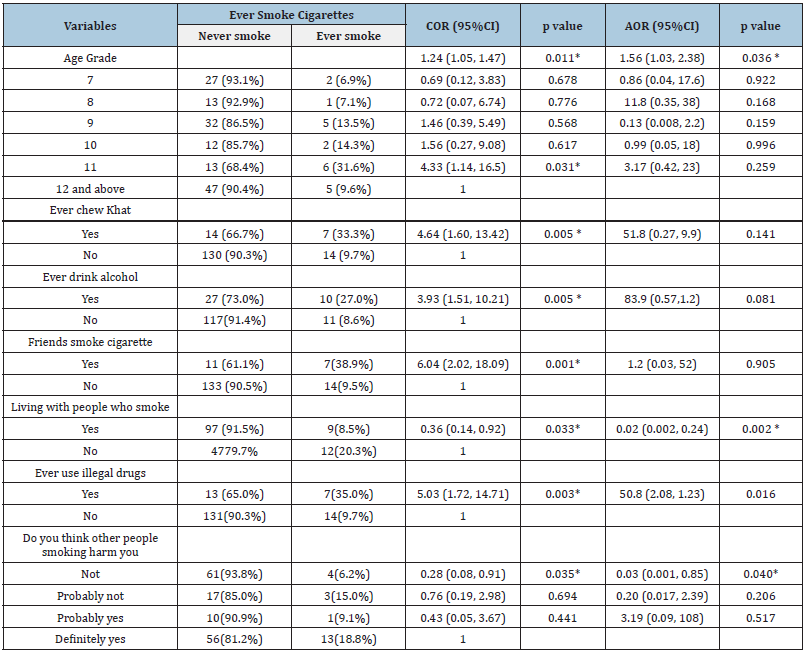
Table 3: Cox proportional hazards model for Factors associated with cigarette smoking status among youth Hawassa, Ethiopia, 2022 (n=165).
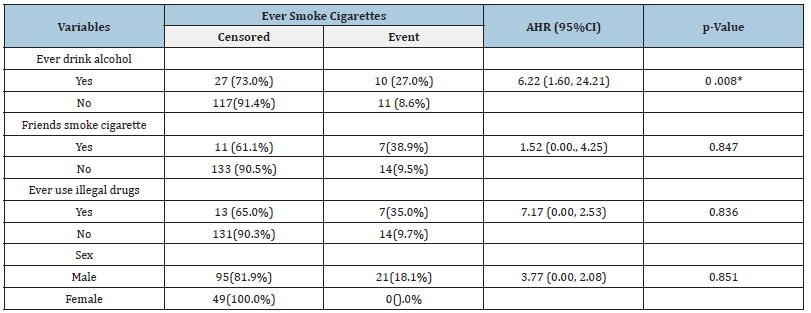
Table 4:An independent sample-t-test that compared differences in smoking by sex.

Table 5:Kaplan meier analysis (with censoring).

Figure 1: Survival plots-smoking.
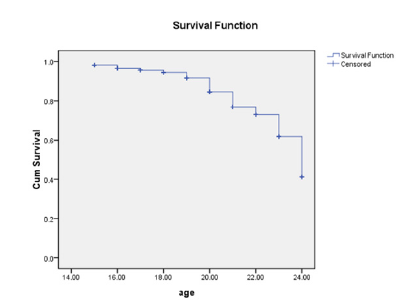
Figure 2: Survival plot for comparison of two groups.
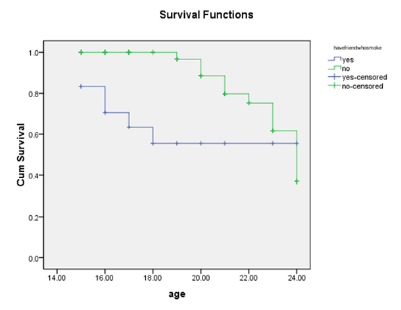
Figure 3: Log minus log plot for the exposure to having friends who smoke and not having friends who smoke.
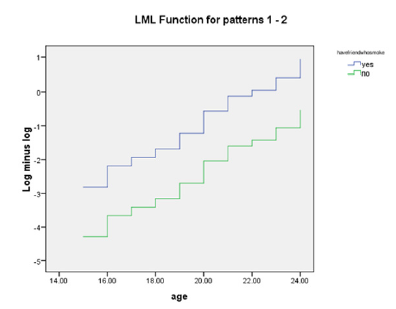
Figure 4:Log minus log plot for youth whoever drink alcohol and youth not ever drink alcohol.
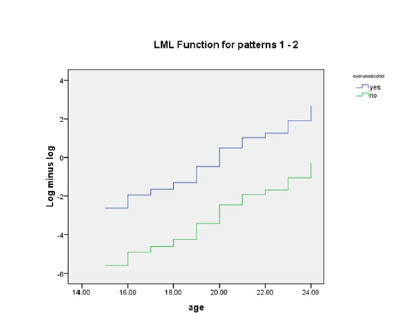
Figure 5: Log minus log plot for youth whoever use illegal drugs and youth not ever use illegal drugs.

Figure 6: Log minus log plot for male youth and female youth.

Discussion
The purpose of the study was to determine the age at which youth began smoking cigarettes, as well as other characteristics, using sequential sampling methodologies (Table 6). Males had a higher smoking history (M=1.18 SD=0.38) than females (M=1.00 SD=0.00) in this study [t (163) = 3.27p=0.001). This is supported by several peer-reviewed investigations carried out in Addis Ababa, Eastern Ethiopia, and Butajira [10-14].
Table 6:Kaplan meier analysis for comparison between two groups.

Test statistics for equality of survival distributions for a group.
This could be related to the region’s cultural and traditional history, where male students are more mobile and responsible for outdoor activities, whilst female students are often responsible for activities within their home. Furthermore, females have more familial ties, such as caring for their families and other relevant societal difficulties, which prevent them from smoking tobacco (Table 7). For every year that you get older, your chances of smoking grow by 56.8%. This is supported by research undertaken in Harar, Ethiopia [15] and Hawassa, Ethiopia [10]. This illustrates that as an adolescent’s age rises, so does the likelihood of testing or smoking. As an adolescent grows older, the likelihood of engaging in risky behaviors increases because of physiological and behavioral changes that lead to smoking (Table 8). When compared to those who do not live with smokers, youth who live with smokers have a 98 percent lower chance of smoking cigarettes. There is no consistent previous study finding with this, and the explanation for this could be that youth living with people who smoke underreport their smoking status in this study, or that the large social and physical environments include influences outside the individual, family, and immediate peer group that may promote or restrict the use of tobacco among youth is a reason to smoke for those youth who do not live with people who smoke (Table 9).
Table 7:The association between having friends who smoke and age to begin smoking.

Table 8:The association between youth who drink and the age to begin smoking.

Table 9:The association between youth who use illegal drugs and age to begin smoking.

When compared to youth who believe smoking from other people damages them, those who believe smoking from other people does not harm them had a 96.6 percent lower chance of using cigarettes. There is no consistent previous study finding with this, and it demonstrated that knowledge about the health effects of cigarette smoking alone did not prevent smoking. We urge that more research be done on the relationship between knowledge about the health effects of smoking and smoking practice (Table 10). Using age as a follow-up period, a Cox proportional hazards model for youth who had ever smoked cigarettes revealed that those who drank alcohol were more likely to start smoking sooner than those who did not. (AHR) (95 percent CI)=6.22, (1.60, 24.21). This evidence is supported by a study conducted in Hawassa [10], Zimbabwe, and another research [16,17]. This could be because cigarettes and alcohol are frequently linked. There is a substantial difference between youth who have a smoking friend and youth who do not have a smoking friend in this study; youth who have a smoking friend take less time to start smoking This conclusion is corroborated by several cross-sectional and case-control studies undertaken in Hawassa [10], Addis Ababa [18], Gondar, and elsewhere, which found a link between tobacco use and peer pressure [19-21]. Having smoking friends may impact both the decision to start smoking and the decision to continue smoking for the rest of one’s life. Furthermore, some teenagers may associate smoking cigarettes with their everyday social interactions with their peers.
Table 10:The association between youth who use illegal drugs and age to begin smoking.

Limitations
First, the cross-sectional design of this study precludes the establishment of causal relationships, necessitating more longitudinal research. Second, the participants’ smoking status was obtained by self-administered questionnaires, which allowed for bias reporting and the likelihood of mistakes in the smoking prevalence among youth. Finally, due to social desirability bias, youth are more inclined to conceal their cigarette smoking behaviors, resulting in an underestimation of cigarette smoking prevalence.
Conclusion
Cigarette smoking is found to be substantially associated with factors such as age, believing smoke from other people does not damage me and living with individuals who smoke. Knowledge of the health implications of cigarette smoking did not prevent smoking, and we propose that more research be done on the relationship between knowledge of the health impacts of smoking and smoking behavior. More research is needed to determine the impact of living with smokers on one’s smoking status.
Declaration
Ethics approval and consent to participate
The ethical review board at Hawassa College of Health Science followed all protocols including the Helsinki Declaration throughout data collection. The ethical review board of Hawassa College of Health Science gave its approval to the project. The data collector informed the respondents that participated in the study was fully voluntary and that there would be no negative consequences if they declined. The data collector was requested online before the data was collected, and each participant gave their informed consent.
Conflict of Interest
There are no conflicts of interests stated by the authors.
Acknowledgment
I would like to thank Hawassa College of Health Science for assisting us with this study project and for study participants.
References
- Mosby (2013) Mosby’s medical dictionary. Elsevier Health Sciences, (9th edn), New York, USA, p. 1984.
- Mowery PD, Farrelly MC, Haviland ML, Gable JM, Wells HE (2004) Progression to established smoking among US youth. Am J Public Health 94(2): 331-337.
- Weiss MG, Eisenberg L (2001) Mental health In International public health. In: Merson MH BR, Mills AJ (Eds.), Maryland: Aspen Publishers pp. 331-378.
- (2013) WHO report on the global tobacco epidemic.
- Central Statistical Authority (2006) Ethiopia demographic and health survey. In: ORC Macro Calverton, Addis Ababa (Eds.), USA.
- Escario JJ, Wilkinson AV (2018) Visibility of smoking among schoolteachers in Spain and associations with student smoking: a cross-sectional study. BMJ Open 8(1): e018736.
- Kliegman RM, Stanton BMD, Geme JS, Schor NF (2016) Nelson Textbook of Pediatrics. (20th edn), Pennsylvania, USA, p. 955.
- Bandason T, Rusakaniko S (2010) Prevalence and associated factors of smoking among secondary school students in Harare Zimbabwe. Tob Induc Dis 8(1): 12.
- Ary DV, Biglan A (1988) Longitudinal changes in adolescent cigarette smoking behavior: Onset and cessation. J Behav Med 11(4): 361-382.
- Duko B, Melese Y, Ebrahim J (2019) Determinants of cigarette smoking among adolescents in Ethiopia: A cross-sectional study. Tob Induc Dis 17: 62.
- Martínez-Mantilla JA, Amaya-Naranjo W, Campillo HA, Díaz-Martínez LA, Campo-Arias A (2008) Daily cigarette smoking among colombian high school students: gender related psychosocial factors. Rev Lat Am Enfermagem 16(5): 903-907.
- Birhanu AM, Bisetegn TA, Woldeyohannes SM (2014) High prevalence of substance use and associated factors among high school adolescents in Woreta Town, Northwest Ethiopia: multi-domain factor analysis. BMC Public Health 14: 1186.
- Schoenmaker N, Hermanides J, Davey G (2005) Prevalence and predictors of smoking in Butajira town, Ethiopia. Ethiop J Health Dev 19(3): 182-187.
- Dereje N, Abazinab S, Girma A (2014) Prevalence and Predictors of Cigarette Smoking among Adolescents of Ethiopia: School Based Cross Sectional Survey. J Child Adolesc Behav 3: 182.
- Reda AA, Moges A, Yazew B, Biadgilign S (2012) Determinants of cigarette smoking among school adolescents in eastern Ethiopia: a cross-sectional study. Harm Reduct J 9: 39.
- Bandason T, Rusakaniko S (2010) Prevalence and associated factors of smoking among secondary school students in Harare Zimbabwe. Tob Induc Dis 8(1): 12.
- Wang M, Zhong JM, Fang L, Wang H (2016) Prevalence and associated factors of smoking in middle and high school students: a school-based cross-sectional study in Zhejiang Province, China. BMJ Open 6(1): e010379.
- World Health Organization (2019) Global youth tobacco survey (GYTS).
- Kassaye M, Taha Sherief H, Fissehaye G, Teklu T (1999) Drug use among high school students in Addis Ababa and Butajira. Ethiop J Health Dev 13(2): 101-106.
- Azale T (2007) Assesment of prevalence and risk factor of chat chewing among in school and out school youth in Gonder town, Ethiopia.
- Rudatsikira E, Dondog J, Siziya S, Muula AS (2008) Prevalence and determinants of adolescent cigarette smoking in Mongolia. Singapore Med J 49(1): 57-62.
© 2022. Kaleab Tesfaye Tegegne. This is an open access article distributed under the terms of the Creative Commons Attribution License , which permits unrestricted use, distribution, and build upon your work non-commercially.
 a Creative Commons Attribution 4.0 International License. Based on a work at www.crimsonpublishers.com.
Best viewed in
a Creative Commons Attribution 4.0 International License. Based on a work at www.crimsonpublishers.com.
Best viewed in 







.jpg)






























 Editorial Board Registrations
Editorial Board Registrations Submit your Article
Submit your Article Refer a Friend
Refer a Friend Advertise With Us
Advertise With Us
.jpg)






.jpg)














.bmp)
.jpg)
.png)
.jpg)










.jpg)






.png)

.png)



.png)






